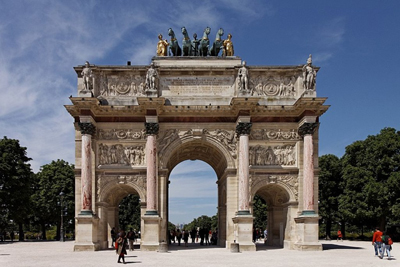
Designed by Charles Percier and Pierre-François-Léonard Fontaine on the model of the Arch of Septimius Severus and the Arch of Constantine in Rome, the Arc de Triomphe du Carrousel is located at the eastern end of the Triumphal Way, the historic axis, between the Louvre Museum and La Defense, the modern business district of Paris. It is in the main walkway from the Tuileries Gardens to the Louvre Museum in the square known as the Place du Carrousel.
Like the famous Arc de Triomphe, this arch was also commissioned by Emperor Napoleon in 1806 to commemorate his victory at the Battle of Austerlitz in 1805 and to honor his grand army.

Built between 1806 and 1808 in Corinthian style, the Arc de Triomphe du Carrousel was originally marked as a monumental gateway to the Palais des Tuileries. However, in 1871, when the Tuileries was burned down during the Paris Commune, it became a symbolic entrance gate to the Tuileries Gardens. Before the disaster, view from the Place du Carrousel to the west was obstructed by the central part of the Palais des Tuilleries. With the ruins of the burned palace swept away, the great axis was opened all the way to the Place du Carrousel and the Louvre.

The19 m (63 ft) high Arc de Triomphe du Carrousel is relatively small compared to the Arc de Triomphe. The 23 m (75 ft) wide and 7.3 m (24 ft) deep structure is composed of three arches. The 21 feet (6.4 m) high central arch is flanked by two smaller ones, of 14 feet (4.3 m) high, and 9 feet (2.7 m) wide. Around its exterior are eight Corinthian columns of white and pink marble, topped by eight soldiers of the Empire: a cavalry soldier wearing a cuirass, (by Taunay), a dragoon (by Corbet), a soldier on horseback armed with grenades (by Dardel), a gunner (by Bridan), a carabineer (by Mutton) and a sapper (by Dumont).



The bas-reliefs, executed in pink marble, depict a series of events: the surrender of Ulm (by Cartellier) and the Battle of Austerlitz (by Esparcieux); Napoleon enters Munich and brings back the king of Bavaria (by Clodion); Napoleon enters Vienna (by Deseine) and the interview of the two emperors (by Ramey); the Peace of Pressburg (by Lesueur). The bas-reliefs, removed by the allied army in 1815, were restored in 1830.
In between the soldiers, the pediment is also adorned with bas-reliefs, depicting: the Arms of the Kingdom of Italy with figures representing History and the Arts; the Arms of the French Empire with Victory, Fame, History, and Abundance; accompanied by Prudence and Victory, Wisdom and Strength holding the arms of the Kingdom of Italy.


The top of the arc is crowned with a beautiful Quadriga, a chariot, drawn by the Horses of Saint Mark, which was plundered by Napoleon from the main gate of Saint Mark’s Cathedral in Venice, which he captured in 1798. However, when Napoleon was ultimately defeated in the Battle of Waterloo, France had to concede the Quadriga to the Austrian Empire, which annexed Venice in terms of the Congress of Vienna. The Austrians, in their turn, promptly returned the statue to Venice. It was ultimately replaced in 1828 by a replica of the Quadriga sculpted by Baron Francois Joseph Bosio, which also included an allegorical figure of Peace riding the chariot, with gilded Victory on both sides. The composition commemorates the Restoration of the Bourbons following Napoleon's downfall.


Originally there was a plan to install a statue of Napoleon in the Quadriga, which was shelved, since Napoleon himself rejected the idea and the chariot remained empty until the restoration of 1828 when an allegorical figure took the place of the emperor.
The Arc de Triomphe du Carrousel is aligned with the Arch de Triomphe, the Grande Arche de la Defenxe and the equestrian statue of Louis XIV in the Cour Napoleon (Louvre).This alignment is known as the ‘Axe Historique’ or the Historical Axis.